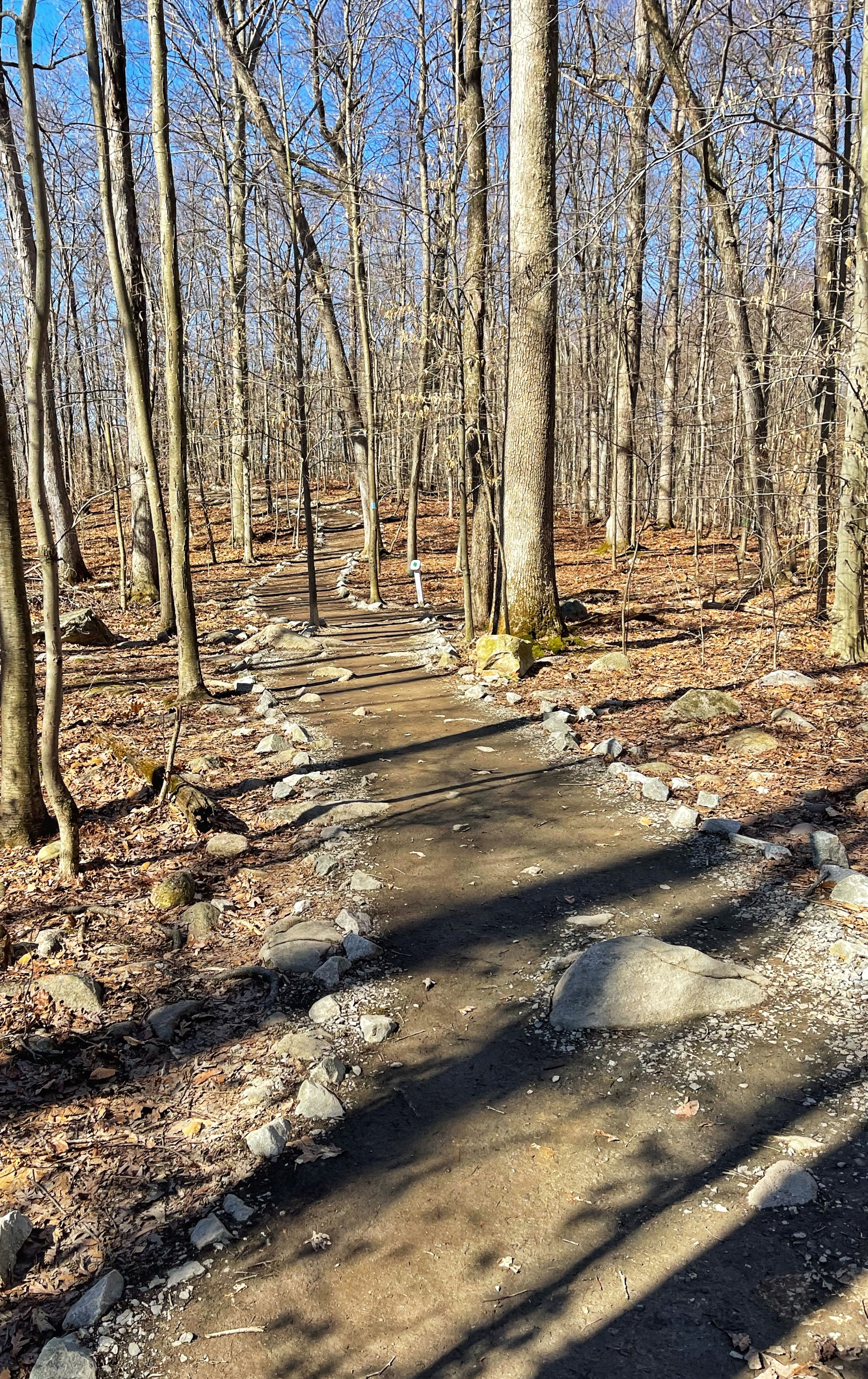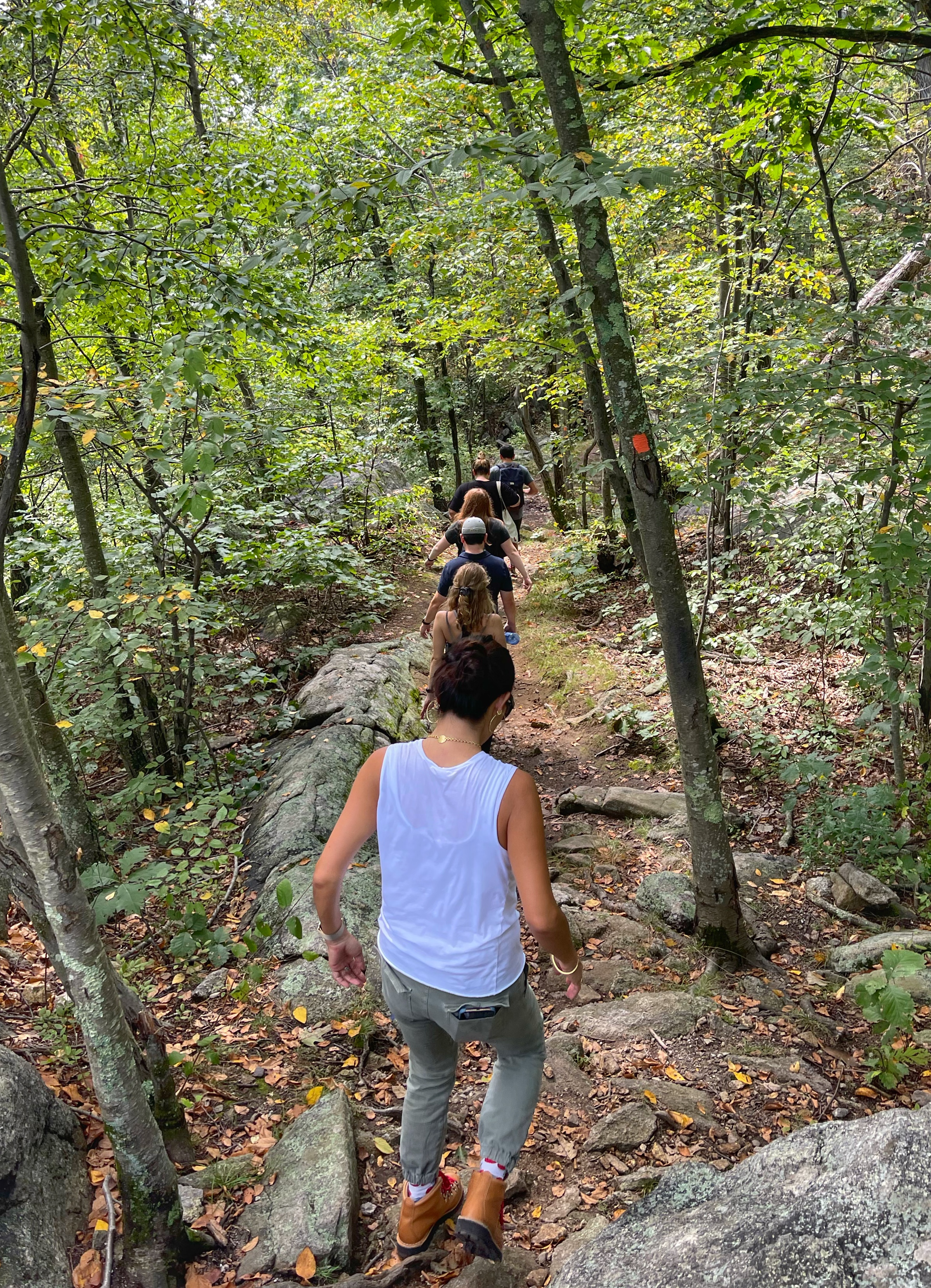Overview
A 3.6 mile loop through forest that features the famous Tripod Rock, some scenic viewpoints, and the Taylortown Reservoir.
Hike Length: 3.6 miles
Elevation gain: +710 feet

Location: Pyramid Mountain National Historical Area, Montville, Morris County, NJ
Parking
Park in the parking lot for Pyramid Mountain National Historical Area. Address: 472 Boonton Ave, Montville, NJ. If the lot is full, park on the shoulder of Boonton Avenue.

Maps
- Pyramid Mountain Natural Historical Area (map with colors) – Morris County Park Commission (pdf)
- Jersey Highlands Trails combined (Avenza)
- Jersey Highlands Trails Map #125 – NY-NJ Trail Conference (print)

Trail description
At the far end of the parking lot is the Visitor Center, which has some nice exhibits on wildlife and the history of the area.

From the parking lot, find the trailhead for the blue-blazed Mennen trail next to the kiosk. The trail begins with a level section lined with stones.

Follow the blue trail across a footbridge over Stony Brook.

Shortly after the bridge, the trail forks – with blue blazes in both directions. You can go either way, but we will go left. The trail climbs steeply up Pyramid Mountain, crossing under power lines along the way. You’ll reach a junction with the orange trail – turn right to climb even more steeply uphill. Once the trail levels off, you’ll see signs for a viewpoint.

The Manhattan skyline can be seen in the distance.
Return to the trail, which gently descends and reconnects with the other fork of the blue trail. Now, the trail turns into the blue dot trail. A short distance later you’ll see a sign for Lucy’s Outlook, named for conservationist Lucy Meyer, the leader of the Committee to Save Pyramid Mountain and a successful preservation effort.

Follow the purple blazes to the overlook, which includes power lines cutting through the Stony Brook Mountains.

Continue to follow the purple blazes back to the blue trail. At the junction is a sign pointing to Tripod Rock. Turn left and continue to follow the blue blazes. After crossing a wet area, you’ll reach the famous glacial erratic called Tripod Rock – a 180-ton boulder that appears to be impossibly balanced on three smaller stones.

The boulder was deposited by the Wisconsin Glacier over 18,000 years ago. This is a great place to take a break and/or pose for some fun pictures.


Also near Tripod Rock are another set of boulders – the “Solstice Stones” – which may have been used as a ceremonial site by Native Americans.

Drawing by Bruce Scofield, CC BY-SA 3.0, via Wikimedia Commons


About 12 m (39 ft) northwest of Tripod Rock are three boulders that appear to form a triangle. The two larger boulders are balanced partially on smaller stones (see diagram). The apex rock is about 3 m (9.8 ft) away to the northeast. Sighting from a bedrock outcrop near Tripod Rock through the two large boulders, the apex of the triangular configuration points to the next ridge on the horizon to the west. This line of sight is toward the setting point of the sun on the summer solstice. During the early 1980s, Tripod Rock and the stones near it were surveyed. The place on the ridge where the sun sets on the summer solstice was visible due to gypsy moth defoliation.[1] A large boulder was visible on the ridge at the place of the summer solstice sunset. Within a year of the survey, a home was constructed on that site and the boulder was displaced by earth-moving machinery. The summer solstice sunset is presently observable near the edge of that residence, and is only partially visible.
Tripod Rock, Wikipedia
Continue to follow the blue dot blazes as it skirts the edge of Big Cat Swamp. You will eventually reach a junction with the orange trail. Continue straight and soon you’ll reach a junction at an information kiosk. Here, the orange trail makes a sharp bend to the right (southeast). Continue to follow the orange blazes. Just beyond the kiosk is an opening in the ridge offering a viewpoint of the mountains to the east and southeast.

Continue to follow the orange trail as it begins a steep descent from the ridge.

At the end of the descent is a viewpoint on the West Bank of the Taylortown Reservoir.

Continue to follow the orange trail as it skirts the edge of the reservoir and sometimes turns inland, with some mostly minor ascents and descents. The orange trail ends at a junction with the blue trail, marked by a large rock cairn.

Stay left here to continue south along the blue trail. In less than a quarter mile the trail reaches the junction where the blue trail splits into a loop. Continue a short distance to cross the footbridge and then follow the blue blazes about 500 feet further back to the parking lot.






